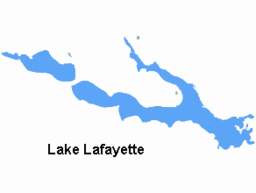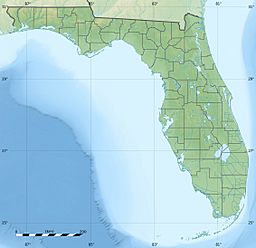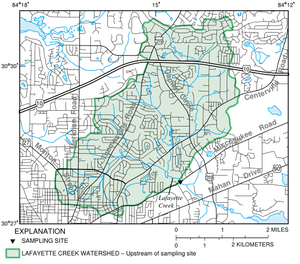Lake Lafayette facts for kids
Quick facts for kids Lake Lafayette |
|
|---|---|

Map of Upper Lake Lafayette, Lake Lafayette, Piney Z Lake and Alford Arm
|
|
| Location | Tallahassee, Leon County, Florida |
| Coordinates | 30°26′15″N 84°10′25″W / 30.4376°N 84.1736°W |
| Type | prairie lake, hypereutrophic |
| Catchment area | 79.6 sq mi (206 km2) |
| Basin countries | United States |
| Surface area | 2.85 sq mi (7.4 km2) |
Lake Lafayette is a special type of lake called a prairie lake. You can find it in the low, coastal area east of Tallahassee, Leon County, Florida. A major road, US 27 / State Road 20, runs close to its southern side.
Contents
History of Lake Lafayette
Ancient Times: How Lake Lafayette Formed
Long ago, Lake Lafayette was known as Prairie Lake. It is what's left of an ancient river delta from the Pleistocene era. During the last ice age, water levels dropped a lot. The coast moved further south, and this area became a river valley. Over time, this valley turned into a tributary of the St. Marks River.
Later, the ground dissolved, forming a huge basin about 8,925 acres wide. A very large sinkhole is located in Upper Lake Lafayette. This area is considered one of Florida's best places to find ancient human history.
Native American Settlements at Lake Lafayette
Many archaeological sites surround the lake. There are many Native American mounds here. One mound that was dug up is now shown at the Florida Museum of Natural History. Large shell mounds, called middens, are found at Lake Piney Z. There are also special Temple Mounds at Fallschase.
Native American settlements were common in the Lafayette Basin. The explorer Hernando de Soto even spent his first Christmas in the New World at one of these sites.
Early Settlers and Plantations
In the early 1800s, settlers in Leon County called it 'Prairie Lake'. This was because it often looked like a grassy prairie during dry periods. The lake got its current name from the Lafayette land grant. This was a large area of land given by the U.S. Congress in 1824 to General Lafayette. It was a thank-you gift for his help in the American Revolutionary War.
By the late 1820s, parts of Lafayette's land around the lake were sold. They became large plantations, each thousands of acres big. Plantations like the Francis Eppes Plantation, Evergreen Hills Plantation, and the Joseph Chaires Plantation grew cotton until the 1860s.
Changes in the 20th Century
Lake Lafayette used to be one big body of water. But in 1948, the owners of Piney Z Plantation built two dirt walls, called dikes. These dikes split the middle of the lake, turning it into a farm pond. More dikes were built later, breaking the lake into smaller parts. These parts are now called Upper Lake Lafayette, Piney Z Lake, Lower Lake Lafayette, and the Alford Arm. This is how the lake began to change into a marshy area with lots of plants.
Of the four main lake areas in Leon County, Lake Lafayette is the most changed by people. It no longer works in a natural way. The Lafayette Basin used to be a temporary lake. Water would often move between the lake, underground water (through sinkholes), and the St. Marks River.
Lower Lake Lafayette now has floating islands of plants, called tussocks. These are usually the roots of decaying water lilies, which are an invasive plant. Aquatic grasses, sedges, and even small trees grow on them. These islands float around the lake with the wind. They can sometimes block or damage boats and docks.
Geography of Lake Lafayette
Lake Lafayette gets its water from Lafayette Creek. This creek drains a large part of northeastern Tallahassee. Its drainage area is about 10 square miles. The creek flows into a small reservoir before reaching Upper Lake Lafayette.
Lower Lake Lafayette used to flow underground into the St. Marks River. After heavy rains, water would also flow over the land into the river. Now, a canal connects Lower Lake Lafayette directly to the St. Marks River.
Lake Lafayette's Water Quality
Lake Lafayette is classified as hypereutrophic. This means it has a very high level of nutrients, which can lead to lots of plant growth.
- Lake Lafayette covers about 2.85 square miles. Its drainage basin is about 79.6 square miles.
- Upper Lake Lafayette is about 0.46 square miles. Its drainage basin is about 23.4 square miles. It is also hypereutrophic.
- Lake Piney Z is about 0.3 square miles. Its drainage basin is about 1.5 square miles. It is also hypereutrophic.
- Lower Lake Lafayette (including Alford Arm) is about 2 square miles. Its drainage basin is about 54.6 square miles. It is also hypereutrophic.
Fun Activities at Lake Lafayette
Lake Lafayette offers many fun things to do outdoors. The Lafayette Heritage Trail Park is a public park in Tallahassee, Florida. It's a great place for families and friends to enjoy nature.
Lafayette Heritage Trail Park Activities
At the park, you can have a picnic, go hiking, or try fishing. Kayaking and mountain biking are also popular activities. The main part of the park is Lake Piney Z, which is a 200-acre lake. This lake is part of the larger Lake Lafayette system.
Around 1950, two dams were built that divided the lake into three parts. Upper Lafayette is still a wet prairie. Piney Z Lake is a 200-acre open water lake. Lower Lafayette looks like a cypress-covered bayou, similar to those in Louisiana. The park is next to the Piney Z Plantation neighborhood and Tom Brown Park. It is open from sunrise to sunset.
Exploring the Trails
Lafayette Heritage Trail Park has many trails for hiking, running, and cycling. You can find a map of the trails here.
Besides walking and biking trails, the park is also the starting point for the Lafayette Passage paddling trail. This is a great way to explore the water by kayak or canoe.
Fishing at Lake Piney Z
Fishing is a very popular activity at Lake Lafayette, especially in Piney Z and Lower Lake Lafayette. Lake Piney Z is the most popular spot. You can access Lake Piney Z from seven special fishing spots called "fishing fingers." There's also a boat ramp where you can launch kayaks and small boats by hand. Only electric motors are allowed on the lake, and you must carry your boat to the water.
Many local people come to fish for largemouth bass and bream. Thanks to the Florida Fish and Wildlife Conservation Commission (FWC), the lake has a healthy fish population. FWC officials have added plants and fish attractors to help fish grow and improve fishing.
Lake Piney Z has many largemouth bass. Most are 9-12 inches long, but you might catch one over three pounds! Bass fishing can be exciting from the shore when a group of fish swims by. Harvesting largemouth bass was once not allowed, but now you can keep them according to FWC rules. Bluegill fish numbers went down when bass harvesting was stopped. But with the new rules and yearly stocking of bluegill in the fall, their numbers are expected to grow again.
Other types of fish you might find in the lake include bowfin, gar, and crappie.





